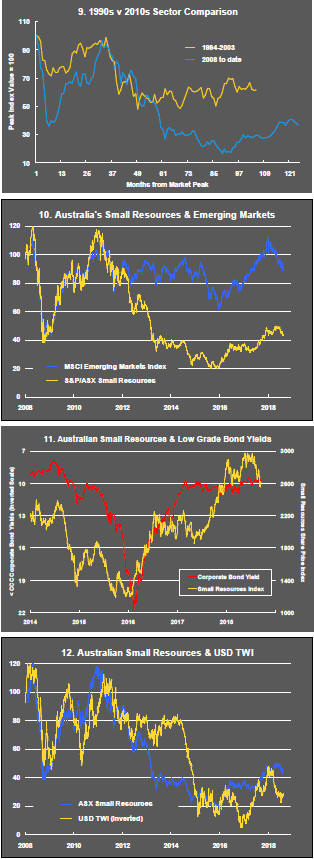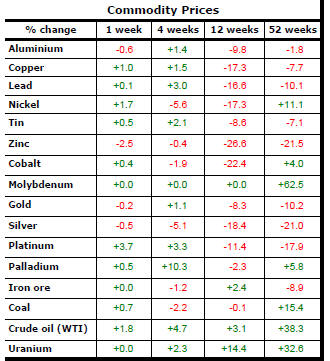The Current View
A lengthy downtrend in sector prices had given way to a relatively stable trajectory after mid 2013 similar to that experienced in the latter part of the 1990s and first few years of the 2000s.
The late 1990s and early 2000s was a period of macroeconomic upheaval during which time sector pricing nonetheless proved relatively stable.
Relative stability suggests a chance for companies genuinely adding value through development success to see their share prices move higher. This was the experience in the late 1990s and early 2000s.
Still vulnerable cyclical conditions were aggravated in the second half of 2015 by a push from investors worldwide to reduce risk. Sector prices were pushed to a new cyclical low. These conditions were reversed through 2016 and 2017 although sector prices have done little more than revert to the 2013 levels which had once been regarded as cyclically weak.
With a median decline in prices of ASX-listed resources companies through the cycle of 89%(and 30% of companies suffering a decline of more then 95%), the majority of stocks remain prone to strong 'bottom of the cycle' leverage in response to even slight improvements in conditions.
Has Anything Changed?
The strength of the US dollar exchange rate since mid 2014 had added an unusual weight to US dollar prices. Reversal of some of the currency gains has been adding to commodity price strength through 2017.
Signs of cyclical stabilisation in sector equity prices has meant some very strong ‘bottom of the cycle’ gains.
Funding for project development has passed its most difficult phase with the appearance of a stronger risk appetite.

Resource Sector Weekly Returns

Market Breadth Statistics

52 Week Price Ranges

Equity Markets
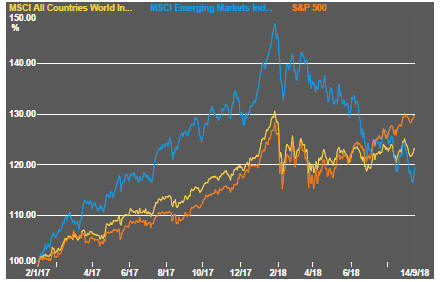



To-ing and fro-ing over trade impacted equity markets once again during the week although, overall, investors appeared to be more relaxed about the prospect of disruption and more prepared to venture back to riskier investments. US markets remained near record levels and emerging market share prices were rising by the end of the week.
There was no apparent progress in NAFTA negotiations although markets appear to be assuming that an agreement between the USA and Canada will be reached at the very last minute after both sides have exhausted their posturing.
Suggestions that the US had reached out to the Chinese government to arrange further discussions about trade also produced more investor optimism although the US government also indicated it was on the verge of extending the range of goods imported from China on which tariffs were to be levied.
Resource Sector Equities



Resource sector related equity prices were edging higher by the end of the week although the directional bias remained negative.
The smaller end of the market fared worse than the market leaders and the mid-tier mining stocks. The PortfolioDirect index tracking the prices of explorers declined again over the week.
Within the Australian market, the principal resources sector benchmark gained against declining non-resource stock prices.
Interest Rates




US government bond yields pushed higher to test the 3% barrier for 10 year securities. The tension between accelerated GDP growth and higher inflation, on the one hand, and US yields sitting below 3%, on the other, are getting closer to resolution.
Turkey gave in to mounting pressure to raise its policy rate. It was expected to do so but the rise was eventually larger than what had been widely anticipated.
Exchange Rates










Developing country currencies remained under pressure although the period of unusually large movements appears to have passed, at least for the time being.
The euro pushed higher after European Central Bank head Mario Draghi’s comments about the direction of inflation and the implication that the central bank would maintain its path toward stimulus removal. Similarly, comments from the Bank of England confirming its commitment to gradual interest rate rises produced a slightly firmer sterling exchange rate.
Commodity Prices
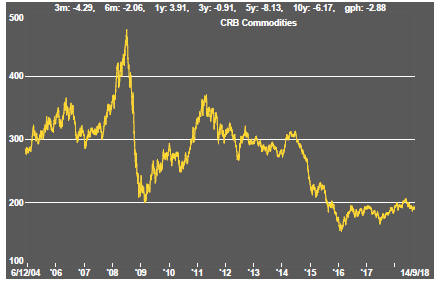
The general upswing in commodity prices since mid 2017 had been given added impetus by stronger crude oil prices.
Diminished momentum has left prices within the bounds of a cyclical trough, albeit at the upper end.
The flip side of the benefits for commodity producers and exporters of higher commodity prices is the cost pressure now being experienced by users of agricultural and raw material commodities. Reporting companies have been suggesting this as a source of margin compression.
Business surveys closely watched by central banks are showing signs of upward pressure on selling prices as a result of higher raw material prices.
Gold & Precious Metals






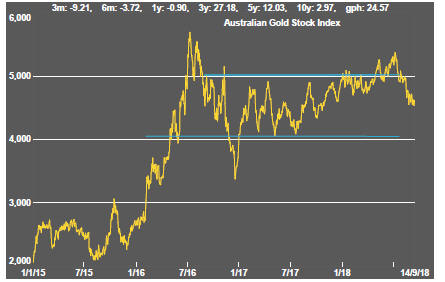
The gold price showed signs of stabilising at the lower levels of recent weeks, around US$1200/oz. The fall in platinum prices has similarly stalled. Palladium prices have shown the strongest signs of recovery, helped by its industrial applications. The silver price displays the least favourable momentum and a strong downside bias.
The gold price has readjusted to levels implied by financial market indicators and which now suggest a period of stability as long as US 10 year bond yields do not push significantly past 3%.
The performance differential between US and Australian listed gold related equities has persisted with the Australian producers being assisted by the weakening Australian dollar.
Nonferrous Metals



Daily traded nonferrous metal prices retain their downward bias despite modest gains in all but aluminium and zinc during the week.
While the metal price weakness has been widely attributed to uncertainty about trade policies, the overall peak in prices occurred in February before tensions over trade had risen significantly and when, more importantly, the consensus about global synchronised growth had begun to splinter.
Around this time, too, forecasts had begun focusing on the limits to growth imposed by structural rigidities limiting national productivity Improvements.
Slightly higher bond yields which would normally suggest improved growth conditions favouring higher raw material prices have not been reflected in the metal price movements which suggest weakening global growth conditions.
Metal prices are less US-centric than bond yields and, consequently, a more telling indicator of what is happening to the global economy overall.
Perhaps US bond prices would have been lower had non-US economic outcomes matched those in the world’s largest economy.
The apparent tension between US bond yields, on the one hand, and metal prices, on the other, is something to watch as a guidepost to the balance of influences in a desynchronised global economy.
Bulk Commodities

Chinese economic growth reports show the national economy meeting its targets, as one would expect for a centrally planned economy, but suggest it is only doing just enough. There are no signs of upside risk. The tariff fight with the USA is beginning to take a toll on activity rates in an economy with a bias toward less strong growth in the years ahead, in any event.
Higher steel prices have not been reflected in stronger iron ore price outcomes despite the improved profitability of the steelworks. Higher production is possibly in anticipation of more government construction stimulus to keep growth on target. There is also uncertainty about the extent of production curbs over the balance of 2018 as environmental restrictions on production are implemented. .
Coal prices continue at high levels reflecting China’s drive to source cleaner energy and as constraints on new mine development keep a rein on supplies.
Oil and Gas


The upward trend in crude oil prices has given way to a leveling out in price although the market did strengthen in the past week. President Trump is again using his position to rail against higher oil prices, urging OPEC members to up output to keep a lid on prices.
OPEC production decisions have helped to support prices as has reimposition of economic sanctions by the US government on Iran. The failure of effective government in Venezuela has been another contributing influence.
The Iranians have been lobbying European countries to prevent more widespread application of sanctions but the likelihood of relief appears slim as long as funds must circulate through US banks.
US production, in any event, continues to rise and is now matching output from Russia and Saudi Arabia. Texas alone is positioned to be the third largest producer after Russia and Saudi Arabia.
Despite the change in tone within crude oil markets, related equity prices have been muted in their responses, implicitly signaling scepticsm about the sustainability of price rises when they have occurred.
Battery Metals


Eighteen months of rising lithium-related stock prices have given way to a prolonged period of market reassessment as a lengthy pipeline of potential new projects has raised the prospect of ongoing supplies better matching expected needs.
Potential lithium producers have been able to respond far more quickly to market signals than has been the case in other segments of the mining industry where development prospects have been slowed by reticence among financiers to back development.
Movements in lithium related equity prices had been aligned more closely with overall sector equity prices in recent weeks although, over the past fortnight, lithium related equities have shown more resilience than their counterparts in other industry segments.
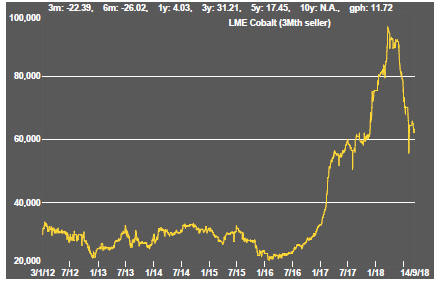
Battery metals remain a focal point for investors with recent attention moving to cobalt and vanadium.
Doubts about a peaceful transfer of political power in the Democratic Republic of the Congo (and instances of Ebola) have added a dimension to cobalt prices lacking in other metals caught up in the excitement over the longer term impact of transport electrification.
In the longer term, cobalt is the most vulnerable of the battery related metals to substitution with high prices likely to stimulate research in that direction.
A spokesperson for Panasonic, manufacturer of batteries for Tesla motor vehicles, has been quoted as saying that the company intends to halve the cobalt content of its batteries because of uncertainties over supply although, offsetting such a move, will be the rapid increase in the number of units produced.
Uranium


The uranium sector is in the midst of forming a prolonged cyclical trough as market balances slowly improve. Power utilities are still not prepared to re-enter the market for contracted amounts of metal to meet longer term needs. A slight upward bias in prices has been evident in the past month.
Slightly higher equity prices from time to time, in the hope of improved conditions, have not been sustained but could be repeated as speculation about improved future demand ebbs and flows. The effect of an announcement by Canadian producer Cameco to extend the duration of its previously implemented production cut gave the market a very slight but quickly lost lift.
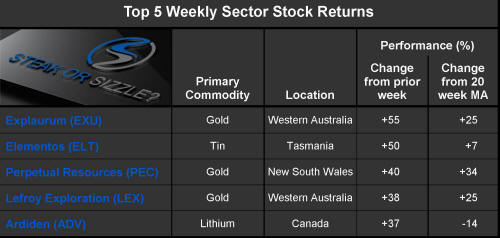
The Steak or Sizzle? blog LINK contains additional commentary on the best performed stocks in the sector and the extent to which their investment outcomes are underpinned by a strong enough value proposition to sustain the gains.

